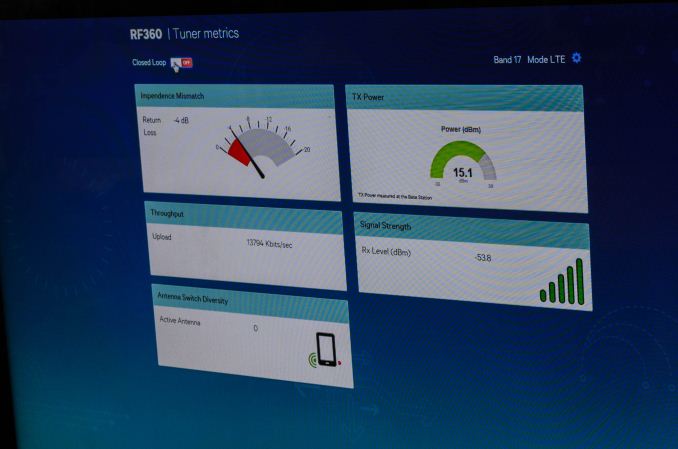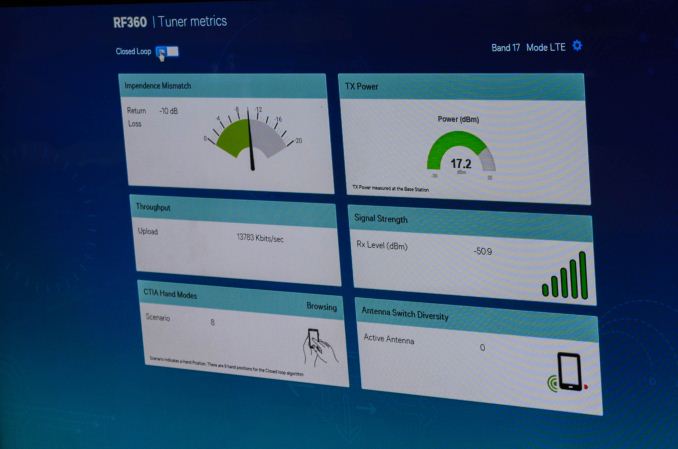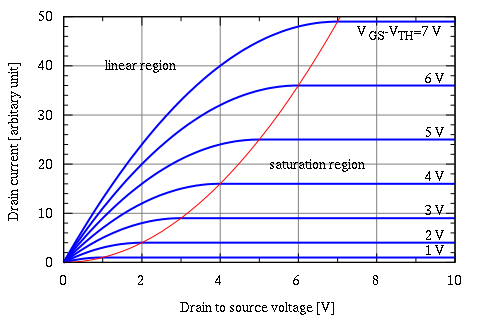Understanding Qualcomm's Snapdragon 810: Performance Preview
by Joshua Ho & Andrei Frumusanu on February 12, 2015 9:00 AM EST- Posted in
- SoCs
- Qualcomm
- Mobile
- Gobi
- Snapdragon 810
QFE2550 Antenna Tuner
One of the first areas to explore would be the RF front end, and before we jump into deep discussions we’ll tackle some of the simpler sections first. The QFE25xx antenna tuner is similar to the envelope tracker in the sense that it’s normally not part of the RF front end. I never actually mentioned an envelope tracker or antenna tuner at any step in the introduction. This is because these parts are not part of the basic superheterodyne radio system. However, like envelope tracking, the need for more battery life, faster data, and superior reception has driven the development of new technologies.
To understand how this antenna tuner works, we must introduce the concept of impedance matching and impedance. Impedance seems difficult at first, but is really just a form of resistance in an AC circuit for the purposes of understanding this article. The three components in a circuit that affect impedance are resistors, capacitors, and inductors. Impedance matching is exactly what it sounds like, which is equalizing the impedance at a junction. In transferring energy from an antenna to the RF front end, we must match the impedance between the antenna and front end. This is because if the impedances are mismatched, signal reflects back to the source. In other words, on the receiving side reception becomes weaker if impedance is mismatched, and on the transmission side energy is wasted. One can liken this to a glossy display, as while the vast majority of the light goes through the glass cover, some light is reflected back.
Of course, in the factory the RF system is carefully tuned to ensure that impedance mismatch is as low as possible. However, the real world makes for a difficult situation. The iPhone 4’s death grip behavior is a classic example of how real-world use can disrupt this impedance matching. By bridging two gaps in the metal ring of the iPhone 4, the antenna was detuned and its impedance was altered. As a result, signal became noticeably worse. Combined with the compressed signal representation, this made it possible for a “decent signal” to be completely lost by touching the right place on the phone.
This is where the QFE2550 antenna tuner and similar systems come in. By acting as a voltage-controlled variable capacitor, the baseband can be loaded with information that allows it to predict how much mismatch correction is needed for each detected scenario, which is accomplished with various sensors that can include capacitive touch sensors. Each situation is compensated for by using pre-loaded corrections that are loaded when a given scenario is detected based on frequency change or body loading scenarios. As a result, the efficiency of the antenna is restored as seen in the photo above, although the presence of body loading will inevitably reduce peak power and sensitivity. Such a system can be combined with more information, such as capacitive touch sensors or reflected power measurements to ensure maximum responsiveness and performance. This has the greatest benefit in enabling phones with all-metal unibodies, although other tools such as antenna switched diversity and MIMO can be used to ensure peak reception.
QFE33xx CMOS PA/Switch
Normally, power amplifiers are not worth talking about. However, with the introduction of RF360 Qualcomm has bandied about the concept of a CMOS PA to cover a wide swath of bands rather than just a few. While this sounds interesting, there’s a great deal more nuance to this issue than simply band coverage. First, semiconductor/solid state physics is required to really understand where the debate lies. Of course, there’s really no time to go over this in major depth, but there are a few basics. The transistor is a switch that controls the flow of current. However, there is a limit to how much current can be carried, and there are a few regions in which the relationship between voltage and current differ. The two that we’ll talk about are the linear region and saturation region. The linear region is exactly what it sounds like. Voltage and current are linearly related, following Ohm’s law. The saturation region is where this falls apart, and more voltage is needed to increase current by the same amount, and we see diminishing returns until maximum current is reached.
"IvsV mosfet" by User:CyrilB. Licensed under CC BY-SA 3.0 via Wikimedia Commons
So this is where we see a fundamental difference in the implementation of a CMOS PA and GaAs PA. Gallium arsenide has higher electron mobility, even in saturation mode. This makes it easier for GaAs circuits to switch at incredibly high frequencies such as 60 GHz for WiGig/802.11ad. In addition, unlike silicon-based transistors, gallium arsenide transistors are generally heat-insensitive, and pure GaAs has high resistance and dielectric constant, which means that it serves as an excellent substrate for various components for the same reasons that silicon-on-insulator (SOI) is a good substrate for CMOS logic. In addition, GaAs-based transistors are highly linear in behavior when compared to CMOS technologies, so a GaAs PA can operate much closer to maximum current without clipping the signal.
However, GaAs is not perfect. For one, CMOS logic is impossible to implement using current technologies. This is because unlike current CMOS technology where there are NMOS and PMOS transistors, GaAs-based transistors do not have a p-channel equivalent. As a result, the controls available over a GaAs PA are significantly cruder than what is possible with a CMOS PA. GaAs PAs are also noticeably less efficient at low power levels, also known as the backoff condition. Therefore, CMOS PAs tend to be more power efficient at lower power states as they can have multiple “maximum power states” to scale the PA as needed. In practice, Qualcomm claims that we’re still looking at around a 5-10% efficiency delta at max power when compared to GaAs PAs, which means that CMOS PAs are close to GaAs PAs in efficiency.
Despite the differences in efficiency, a CMOS PA is still a valid option in smartphones due to the fact that a single PA can cover far more bands than an equivalent GaAs PA, as the PAE curve across a spread of frequencies is relatively flat compared to a GaAs PA which is effectively a single peak. In addition, the fact that the PA is built on CMOS means that there is additional integration capability. In its current incarnation, the QFE33xx already has an integrated antenna switch, and there is potential for greater integration with parts that share a similar process node.
This concludes RF360, which gives a broad survey of what’s on the market today. Combined with our previous piece on MDM9x25, it’s possible to get a good idea of the current state of the market. However, the latest and greatest modems and transceivers mean that it’s time to talk about UE category 6, 9, and 10 LTE and the various challenges that come with new capabilities.














119 Comments
View All Comments
phoenix_rizzen - Thursday, February 12, 2015 - link
Asus ZenPhone 2 uses an Intel chipset.There's a couple of other ones as well.
blanarahul - Thursday, February 12, 2015 - link
It's probably at Snapdragon 800 level. Intel won't compete with S810 and best Exynos' of the world until Airmont.... Well, atleast I hope so. *sigh*serendip - Friday, February 13, 2015 - link
Intel on Android also has problems with app compatibility and speed, despite Intel's assurances to the contrary. Apps with ARM-compiled native codeserendip - Friday, February 13, 2015 - link
Apps with ARM-compiled native code either don't run or run slowly under the code translator. It's almost like Intel is giving away these phone and tablet Atom SOCs to get a foot in the mobile market. I'm quite happy with my cheap Windows 8.1 tablet but Android on Intel has a way a to go yet.(the lack of comment editing isn't fun, especially when the Submit Comment button is so easy to click)
phoenix_rizzen - Friday, February 13, 2015 - link
That's for (mainly) games developed using the Android NDK, correct? Doesn't the switch to the Android RunTime (ART) and pre-compiling the apps at install time mitigate this? Or does ART not apply to NDK apps?jjj - Thursday, February 12, 2015 - link
Look at the phrasing from 2 articles at just a few days distancein this one - Thanks in large part to the new cryptographical capabilities of the ARMv8 cores, Snapdragon 810 gets off to a very good start in Geekbench 3's integer benchmarks ....Snapdragon 810's overall performance improvement here is a rather large 45%, though if we throw out the especially large gains that come from Lua MT, the overall performance advantage is closer to 30%.
and from the Note 4 - GeekBench's integer benchmarks paint a similar picture - if we disregard the huge boost to the cryptography scores we see an average advantage of 31% for the Exynos 5433's A57 cores, or 29% when we normalize for clock speeds.
So for the Note they clearly point out and discard the encryption gains and they normalize for clocks. That's good and fair and the proper way to look at it. (although quantifying the importnace of the encryption gains would be a plus).
Here not only encryption is left alone but clocks are not even mention, some readers might not be even aware that there is a clock difference.
The tone and objectivity are fundamentally different, a nice review for the Note while here it's all about easing concerns and making SD810 look good.
Sushisamurai - Thursday, February 12, 2015 - link
+1. It's not unethical, because it's on a reference platform that Qualcomm is sourcing out. It'd be "unethical" (your terms, not mine - I would use the word disappointing) if they didn't give investigate throttling and power for actual, retail/shipping devices. But I haven't been disappointed yet so....gonchuki - Friday, February 13, 2015 - link
2015 was already going to be a good skip year with flagships already going full retard at 6'' in late 2014 and already gimping the specs of 5'' phones just to increase the sales of their higher margin phablets.Andrei Frumusanu - Thursday, February 12, 2015 - link
I added the clocks for the CPU, apologies the article was still being edited when published.As for power and thermals, we have no way to test these until we get a shipping review device with the SoC. Josh had only a couple of hours on hand with the MDP, making more extensive testing not possible. Calling that unethical is pretty harsh.
warreo - Thursday, February 12, 2015 - link
Andrei, power and thermals aside, I notice you didn't address why there was not a greater focus on Exynos vs. S810? At bare minimum, you should include the % difference in the table in addition to the difference vs. S805. The absence of any kind of discussion there makes it easy for people to cry unethical, NOT the absence of power and thermals, which as you said, was due to lack of testing time.